
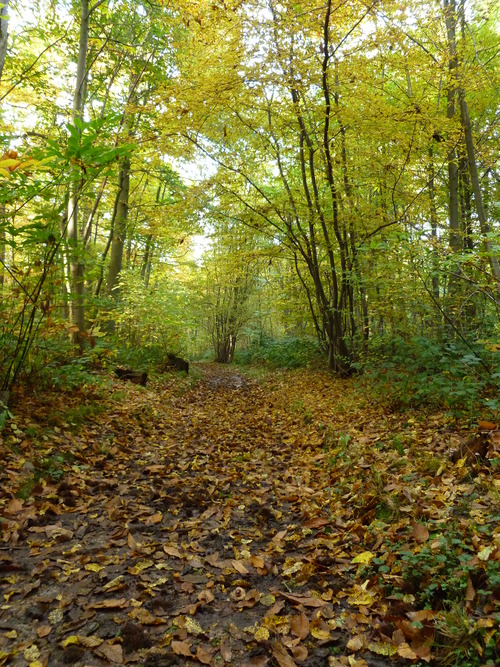
I was hoping to have the new version of the site up before making this post, but it’s not ready just yet, although it soon will be. So, as you will notice, the article has been posted a little later than when it was written.
It’s been an incredibly warm October this year, 11c today, but often 17-20c, far different to how I remember it last year, and certainly not in-line with how we all imagine October and the late autumn months to be.
October is one of my favourite months of the year, especially when it’s cold, and bleak. I look forward to seeing the hedgerows decorated with spider webs, and golden autumnal colours adorning the ground from the fallen leaves, often hiding the occasional edible species of mushroom. But this year, it seems the changes October usually brings will shift to November.
As always, I seem to be working and not really getting out of the workplace to concentrate on foraging, but I do always make it a yearly tradition to look for Walnuts Juglans regia and Sweet Chestnuts Castanea sativa. Unfortunately the trip to gather walnuts ended in disappointment, as the local trees that I know to produce a good crop each year have been cut down and the site used for yet more development. It’s such a shame, but sadly the way things seem to go these days, and I can’t see anything changing any time soon!
The trip to collect the sweet chestnuts was a much nicer experience however. It was my mum’s birthday, so I asked if she wanted to join me and my little boy for woodland walk. When we first arrived, I was, once again a bit disappointed, as my favourite trees had also been cut down (I feel a common theme beginning to form), but on this occasion it was mainly due to the traditional form of coppicing, an ancient method of woodland management, which does have some benefits, although it seems to be a practice that is all too often used in my opinion, mainly because conservationists feel the need to “manage” everything, which is fine, and in some circumstances correct to do so, but in some woodlands and some other places it is OK to leave old trees standing! Anyway, I digress.
Because we’ve had a late “Indian” summer, the nuts have matured a little earlier than they usually do (if they do at all), so in all honesty I was a little late to make the trip this season, but nevertheless there were still plenty to be found amongst the leaf litter.
I was expecting my little boy, Orin, who is 2 years old, to be put off because of the exceptionally sharp outer casing of the nuts. For those not familiar with them, I can only compare them to needles (many of them), but of the three of us he was the only one who was able to handle them without the occasional pricked finger, quite how he managed this I don’t know, but he did. Orin was in charge of the nut trug (basket), although he favoured a bright green bucket from his sandpit, so we used that most of the time. He happily gathered a good crop over the course of an hour or so and only dropped the lot on two occasions, which he seemed to find quite entertaining!
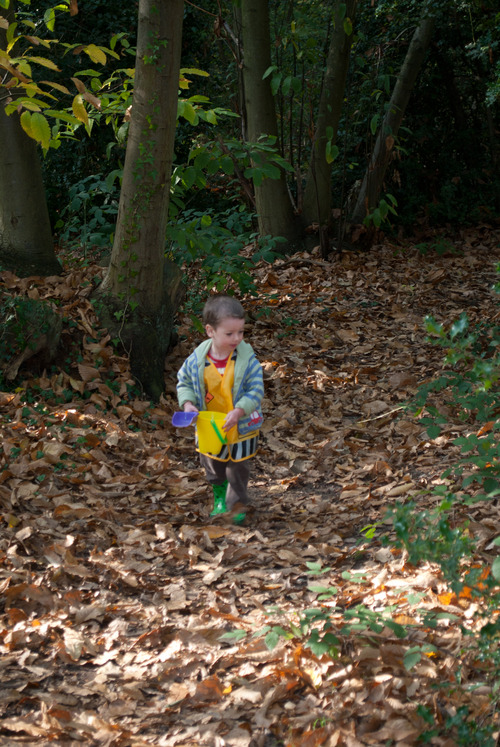
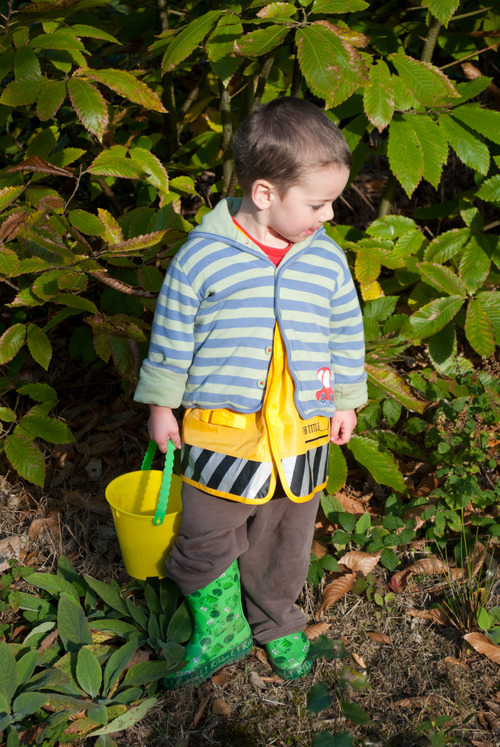
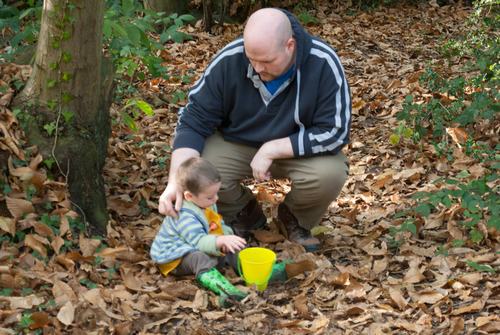
The chestnuts were slightly past their prime, I’d say by a couple of weeks, but we still managed to gather enough to roast some on Bonfire Night, and I’ll make Orin something with his, because they seem incredibly easy to choke on, even when cooked. I think this is primarily due to their crumbly nature, and almost mouth-drying outer surface.
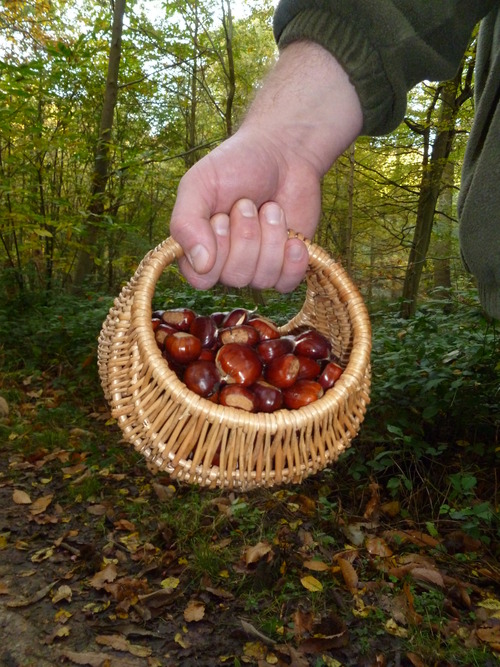
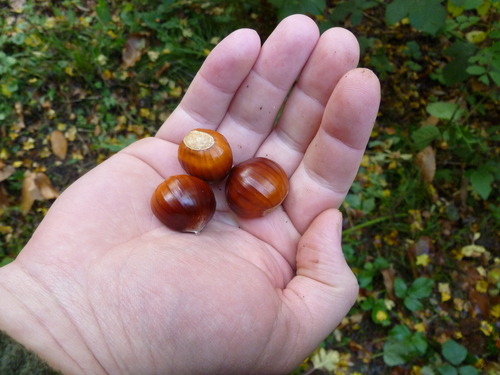
There are several ways to enjoy them, but for me, the simplest method is the best, and has a dual purpose. On a cold November night, preferably Guy Fawkes Night (Bonfire Night), throw some in the embers of a fire, remembering to pierce the shell of them all, apart from one nut. When you hear this nut explode, it means the others are fully cooked and ready to be retrieved from the hot coals. At this stage, if you’re standing around waiting for the fireworks to begin popping in the sky, put them in your pocket and use them as a hand-warmer (they may need to cool a little first of course).
The heat should have made the cut in the shell expand, so now all you need to do is shell them and eat the carbohydrate-rich inner part.
Of course if you’ve left it too late to gather your own, then you can usually purchase some in the shops (usually Spanish ones) which will not be as fresh as a hand gathered haul, but they will still be a nice treat at this time of year, and they can be cooked in the oven/grill the same way as described with the fire method of cooking, although if they explode you will be finding shards of them in the oven for a few weeks to come!
Another nice thing to do with them, when you have an overabundance, is to make a Christmas stuffing with them. This can be a stand-alone type stuffing, or used with pork. I won’t give an exact recipe here, as I believe cooking is about tasting and feeling your way to your desired result, well, most of the time anyway. I always use sharp tasting cranberries, sherry, and a few Christmas spices mixed in with some blended chestnuts which have been soak in your chosen tipple (usually the sherry, or whisky). It always seems to go down well, but be careful it doesn’t go dry! It does seem to freeze well.
One thing that I should point out to those who are not completely familiar with foraging for the Sweet Chestnut Castanea sativa is that they are a completely different species to that of the Horse Chestnut (conker) Aesculus hippocastanum. Horse Chestnuts should not be eaten, as they are toxic. So, what are the differences you may ask?
The basic differences
1) The husk has many more and much finer points than that of a conker husk. They are both spiky, but the outer shell of the Horse Chestnut (Conker) is easy to handle, whereas the Sweet Chestnut to too sharp to handle without a few swear words teetering on the tip of one’s tongue!
2) The ‘nut’ of the Sweet Chestnut comes to a slight point, sometimes with tiny silky hairs visible. Conkers on the other hand are round, or roundish with no visible point, although when two or more form tightly together they can boast a prominent edge. As a Child I’d always call a conker with an edge a ‘cheese’, which is often capable of destroying an opponent in the game of conkers.
3) Sweet Chestnut trees tend to stand together in woodlands. Horse Chestnut trees are often standing alone, or in small patches on parkland or larger gardens.
4) The leaves are quite different. Sweet Chestnut produce long leaves that have around 20 pairs of straight parallel veins each ending in a saw shaped tooth at the edge. The Horse Chestnut generally has 7 (on occasion 5 or 6) stalkless leaflets spreading from a central stem. The leafelts are jagged and double toothed; the whole leaf resembles a large hand.
5) The bark of Sweet Chestnut is silvery with vertical cracks on young trees. Older trees develop a network of ridges which spiral up the tree. The Horse Chestnut has quite smooth bark which is pinkey grey when young.
There are of course many other differences that separate these two lovely trees, but those detailed above are some of the more basic and notable distinctions between them.
I hope you all had a nice Halloween, and please have a safe Bonfire Night on November 5th.
Catch you the trail
Kris

Riccardo on 15/10/16
Hello
Thank you for this blog, I'd love to take my kids to a similar hunting adventure and I wonder whether you would share the place with us?
:-)
thanks
Ric
Kevlandy on 12/11/16
Well, I'm thinking of heading out tomorrow (Nov. 13), I hope there are some left that haven't gone over.
Work commitments have stopped me making the (27 mile) trip sooner.
- Thanks for the interesting read. :-)